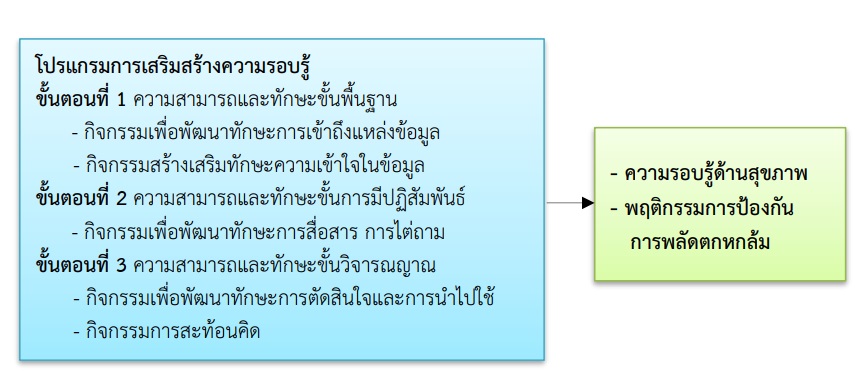ผลของโปรแกรมการเสริมสร้างความรอบรู้ด้านสุขภาพต่อความรอบรู้ด้านสุขภาพและ พฤติกรรมการป้องกันการพลัดตกหกล้มของผู้ดูแลผู้สูงอายุกลุ่มเสี่ยง ในเขตเทศบาลนครตรัง
คำสำคัญ:
โปรแกรมการเสริมสร้างความรอบรู้, ความรอบรู้ด้านสุขภาพ, พฤติกรรมการป้องกันการพลัดตกหกล้ม, ผู้สูงอายุบทคัดย่อ
การวิจัยกึ่งทดลองแบบสองกลุ่มวัดผลก่อนและหลังการทดลองนี้ มีวัตถุประสงค์เพื่อศึกษาผลของโปรแกรมการเสริมสร้างความรอบรู้ด้านสุขภาพต่อความรอบรู้ด้านสุขภาพและพฤติกรรมการป้องกันการพลัดตกหกล้มของผู้ดูแลผู้สูงอายุกลุ่มเสี่ยง ในเขตเทศบาลนครตรัง กลุ่มตัวอย่าง คือ ผู้ดูแลผู้สูงอายุที่มีภาวะเสี่ยงพลัดตกหกล้มในเขตเทศบาลนครตรัง จำนวน 58 คน แบ่งเป็นกลุ่มควบคุมและกลุ่มทดลอง กลุ่มละ 29 ราย เครื่องมือที่ใช้ในการเก็บรวบรวมข้อมูล ได้แก่ แบบสอบถามข้อมูลส่วนบุคคลของผู้ดูแลและผู้สูงอายุ แบบสอบถามความรอบรู้ด้านสุขภาพและแบบสอบถามพฤติกรรมการป้องกันการพลัดตกหกล้มในผู้สูงอายุ ได้ผ่านการตรวจสอบความตรงของเนื้อหาโดยผู้ทรงคุณวุฒิจำนวน 3 ท่าน และทดสอบความเชื่อมั่นของแบบสอบถามความรอบรู้ด้านสุขภาพด้านความเข้าใจโดยใช้ KR 20 ได้ค่าเท่ากับ .73 ด้านการเข้าถึง ด้านการไต่ถาม ด้านการตัดสินใจ และด้านการนำไปใช้ รวมทั้งเครื่องมือพฤติกรรมการป้องกันการพลัดตกหกล้ม ทดสอบโดยการหาค่าสัมประสิทธิ์แอลฟาของคอนบาคได้ค่าความเชื่อมั่นเท่ากับ .93 และ .81 ตามลำดับ วิเคราะห์ข้อมูลโดยใช้สถิติทดสอบค่าเฉลี่ย ผลการวิจัยพบว่า
1, กลุ่มทดลองมีคะแนนเฉลี่ยความรอบรู้ด้านสุขภาพและพฤติกรรมการป้องกันการพลัดตกหกล้มหลังได้รับโปรแกรมฯ (M=113.45, SD=15.25 และ M=82.0, SD=9.07 ตามลำดับ) สูงกว่าก่อนได้รับโปรแกรม (M=96.45, SD=8.19 และ M=76.83, SD=8.63 ตามลำดับ) อย่างมีนัยสำคัญทางสถิติ (t=7.28, p<.001 และ t=14.31, p<.001 ตามลำดับ)
2. กลุ่มทดลองที่ได้รับโปรแกรมฯ มีคะแนนเฉลี่ยความรอบรู้ด้านสุขภาพและพฤติกรรมการป้องกันการพลัดตกหกล้มหลังได้รับโปรแกรมฯ (M=113.45, SD=15.25 และ M=82.0, SD=9.07 ตามลำดับ) สูงกว่ากลุ่มควบคุมที่ไม่ได้เข้าร่วมโปรแกรมฯ (M=96.83, SD=13.67 และ M=76.03, SD=7.38 ตามลำดับ) อย่างมีนัยสำคัญทางสถิติ (t=4.37, p<.001 และ t=2.75, p<.01 ตามลำดับ)
ผลการศึกษาครั้งนี้สามารถนำโปรแกรมการเสริมสร้างความรอบรู้ด้านสุขภาพมาใช้ในการป้องกันการพลัดตกหกล้มในผู้สูงอายุ และประยุกต์ใช้ให้สอดคล้องกับระดับความรอบรู้ด้านสุขภาพของผู้ดูแล
เอกสารอ้างอิง
Berkman, N. D., Sheridan, S. L., Donahue, K. E., Halpern, D. J., Crotty, K. (2011). Low Health Literacy and Health Outcomes: an Updated Systematic Review. Ann Intern Med. 19, 155(2), 97-107.
Cohen, J. (1988). Statistical Power Analysis for the Behavioral Sciences (2nd ed.). Hillsdale, NJ:
Choeisuwan, V. (2018). Health Literacy: Concept and Application for Nursing Practice. Royal Thai Navy Medical Journal, 44(3), 183-197. (in Thai).
Daniel, S. (2014). Statistic Calculator: A-Priori Sample Size Calculator for Student t-test. Retrieved January 20, 2022 from http://danielsopercom/statcalc3/default.aspx.
European Health Literacy Consortium. (2012). Comparative Report on Health Literacy in Eight EU Member States [Internet]. The European Health Literacy Survey HLSEU. Retrieved February 24, 2022 from http: www.HEALTH-LITERACY.EU.
Foundation of Thai Gerontology Research and Development institute. (2020). Situation of the Thai Elderly 2020. Retrieved December 12, 2021 from https://thaitgri.org/?p=39772 file:///D:/Users/hp/Downloads/ThaiElderly_2563%20(2).pdf
Gladdar, S. F., Valerio, M. A., Garcia, C. M., & Hansen, L. (2012). Adolescent Health Literacy: the Importance of Credible Sources for Online Health Information. Journal of School Health, 82(1), 28-36.
Institute of Geriatric Medicine, Ministry of Public Health. (2019). Practice Guideline for Fall Prevention and Assessment in Older Adults. Retrieved November 14, 2020, from http://agingthai.dms.go.th/agingthai/wp-content/uploads/2021/01/book_9.pdf.
Jaemtim, N., Yuenyong, S., & Srisodsaluk, P. (2018). Effects of Preparation to Care for Elderly Program at Sanamchai Subdistrict Mung District Suphanburi Province. Nursing Journal of the Ministry of Public Health, 25(3), 108-119. (in Thai).
Kaeodumkoeng, K. (2019). Health Literacy: Process, Practice, Evaluation Tools. Bangkok: ID Oil Digital Printing Lt.d. (in Thai).
Kulapeng, W., Anothaisinthawee, T., Pantumongkol, W., Wisaiprom, J., & Tuntiweas, S. (2018). A Study on the Introduction of Community-based Preventive Interventions for Fall and Dementia in the Thai Elderly. Health Intervention and Technology Assessment Program, Ministry of Public Health. (in Thai)
Ministry of Public Health. (2019). Health Promotion and Dementia Prevention of Older Adults Manual for Health Personnel “Do Not Fall, Do Not Forget, Do Not Depress and Good Eats” Retrieved December 12, 2021 from http://203.157.212.7/ltc/document/m002.pdf.
Matsee, C., & Waratwichi, C. (2017). Promotion of Health Literacy: from Concept to Practice. Boromarajonani College of Nursing, Uttaradit Journal, 9(2), 96-111. (in Thai).
Noopud, P., Phrom-On, D., Woradet, S., & Chaimay, B. (2020). Prevalence of Fall Risk and Factors Associated with Fall Risk among Elderly People. Journal of Sports Science and Health, 21(1), 125-137. (in Thai).
Nutbeam, D. (2008). The Evolving Concept of Health Literacy. Social Science and Medicine, 67(12), 2072-2078.
Photihung, P. (2021). Relationship of Health Literacy to Health Promoting and Disease Prevention Behaviors in Thailand: A Systematic Review. Relationship of Health Literacy to Health Promoting and Disease Prevention Behaviors in Thailand: A Systematic Review. The Journal of Faculty of Nursing Burapha University, 29(3), 115-130. (in Thai).
Pinarad, K., Sitipongsakul, S., Patthananurak, S., Nualkale, A, Worauon, S. (2019). Development of Elderly Caregiver with Public Conciousness Model. Retrieved December 25, 2020 from https://oldweb.western.ac.th/media/attachments/2019/02/09/mind.pdf
Polit, D. F., & Beck, C. T. (2012). Nursing Research: Generating and Assessing Evidence for Nursing Practice. (9th ed.). Philadelphia, Pa: Lippincott, Williams & Wilkins.
Pongaumpai, P., Hoontrakul, S., & Roojanavech, S. (2018). The Effects of Family Empowerment Program on Fall Prevention Capabilities of the Elderly. Royal Thai Navy Medical Journal, 45(2), 311-327. (in Thai).
Public Health Office of Trang. (2020). The Report of Chronic Patient Data 2019. Retrieved December 20, 2021 from: http:// tro.moph.go.th/provis/main/index.php.
Santwanpas, N., Srijaranai, S., Radabutr, M., Pragodpol, P., Chawajaroenpan, W., & Waisurasing, L. (2019). The Development of the Health Literacy on Fall Preventions for Older People in Community Health Region 4. Journal of The Police Nurse, 11(1), 95-106. (in Thai).
Sarapun, A., Sirisopon, N., Kainaka, P., Onsiri, S., Outayanik, B., Threrawachjareanchai, S., & Sukomol, N. (2017). Factors Related to a Fall Prevention Behaviors of Elderly. Journal of The Royal Thai Army Nurses, 18(Special), 215-222. (in Thai).
Simplee, S., & Banchonhattakit, P. (2019). Effects of Health Literacy Promoting Programs and Exercise by Applying Maneewach Exercise for Preventing Fall in Older Adult in Buriram Province. Journal of Health Education, 42(2), 149-159. (in Thai).
Strategy and Planning Division, Ministry of Public Health. (2020). Public Health Statistic. Retrieved December 20, 2020 from http://www.35.190.29.12/uploads/files/1662820210118045737.pdf.
Tasuwanin, T., & Tappakit, K. (2017). Effects of a Falling Prevention Program for Elderly. Journal of Nursing and Health Care, 35(3), 186-195. (in Thai).
World Health Organization. (2014). The Health Literacy Toolkit. Retrieved May 12, 2022. from http://www.searo.who.int/entity/ health promotion/documents/hl_tookit/en

ดาวน์โหลด
เผยแพร่แล้ว
ฉบับ
ประเภทบทความ
สัญญาอนุญาต
ลิขสิทธิ์ (c) 2022 วารสารการพยาบาลและการศึกษา

อนุญาตภายใต้เงื่อนไข Creative Commons Attribution-NonCommercial-NoDerivatives 4.0 International License.





